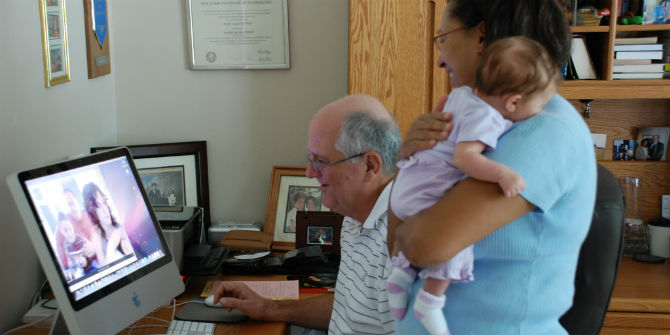What foster and adoptive parents need to know about digital media PART 1: The benefits
June 30, 2015
PROJECTS: Preparing for a Digital Future The Class
TAGS: parenting
Looked after children are particularly vulnerable and Alicia Blum-Ross discusses some of the opportunities of digital media for foster and adoptive children. She finds that these can help young people to hold on to precious memories and relationships, to seek support and community, and to enjoy and learn. Alicia is a researcher at the LSE’s Department of Media and Communications. She is interested in youth media production and is part of the Parenting for a Digital Future research project.
Children and young people who are ‘looked after’ by the state are more likely than their peers to have experienced serious trauma and hardship. Many of the experiences that lead to a child being in foster care, a group home, or to being adopted – from physical or emotional abuse and neglect to substance abuse to parents who are unwilling or unable to parent – leave these children particularly vulnerable. As we know from previous research, children who have multiple, sometimes overlapping, vulnerabilities offline are also those who are generally at the greatest risk of harm online.
Foster and adoptive parents and social workers therefore have a particular reason to make sure the children and young people they care for are using digital media safely. But at the same time, as I learned at an excellent conference this month on Fostering in the Digital Age run by the UK organisation The Parent Zone, there are a number of unique opportunities that digital media present to looked-after children too.
In today’s post, I summarise some of the particular benefits that digital media can present to looked-after children and young people. Next week in part II of this post, I turn to some of the unique challenges and risks. Both of these posts are based on the wonderful (and unusually even-handed) presentation that expert Eileen Fursland, who writes about social media and adoption, made at the conference.

Credit: J. Shlabotnik, CC BY 2.0
The benefits of digital media
- Ongoing, cost-effective contact: where contact with the birth family is helpful for and wanted by the child, birth family and foster/adoptive parents, digital media allow many different ways of communicating – from Skype and FaceTime to occasional check-ins on social media. This can help children who are placed far away from the birth family, or where either party may be unable to visit due to illness, cost, disability etc.
- Capturing the child’s life story: sites like Facebook or Instagram can act as an evolving and easily updated interactive ‘digital life storybook’ for looked-after children, helping them keep track of important places and people in their lives, and holding those people and memories close if they are moved between placements.
- Feeling ‘normal’: taking part in activities like gaming can help children and young people, including those with disabilities, feel respected by and connected to others, especially if they are isolated at school due to having moved around.
- Family-finding: in the US, there is a growing trend for social services to try to find a relative who can take the child in before they are placed in care. Social media and genealogy sites have been used either to find relatives to care for a child or at least to form a relationship that might help the children in the longer term. This promising idea is still in its infancy in the UK.
- New ways of communicating: digital media, including texting and social media, offer children and young people a way to communicate that isn’t face-to-face, which many may find intimidating. One social worker described how a young man he looks after would text him to talk about issues with his birth family, even when he was in the same room, because it was too difficult for him to describe his problems out loud. In the US, a pilot service gave foster children iPads so that they could communicate from rural locations and have remote therapy with counsellors.
- Finding a voice and community:social media enables young people to talk to each other, share experiences, and sometimes provide feedback on their experiences in care. This can be ‘top-down’, for example, councils set up for children in care to talk to each other or to social workers, or ‘bottom-up’, for instance, the young people who set up a Facebook group called the Topé Project to help care leavers get together to avoid feeling isolated during the holidays when their peers are with their families. There are is even an app, Mind of My Own, designed specifically for children and young people to communicate concerns and views to social workers and foster carers. The very-inspiring Luke Rogers, a care leaver who established the social enterprise Foster Focus, even suggested helping young people to have a voice in their care provision by encouraging social workers to check in with young people during a shared game of FIFA… with the young people’s knowledge, of course.
These are just some of the ways that digital media presents opportunities for looked-after children and young people to hold on to precious memories and relationships, to seek support and community, and to enjoy and learn. It was noticeable in Eileen’s discussion that there seemed to be little systematic research (but a lot of anecdotes) about the benefits of digital media use for looked-after children and young people. Surely it is time to build this evidence base.
Although promising, these myriad uses of digital media also come with their own challenges – practical, ethical and sometimes legal. Next week in part 2 of this post, I consider the better-known flip-side to this discussion, the possible risks and difficulties that digital media introduce for looked-after young people.


